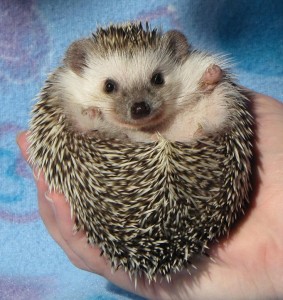Caring for and Getting to Know Your New Hedgehog
If you’re thinking about adding a new hedgehog to your family, you’ll first want to consider whether he or she will fit your lifestyle and personality. Hedgehogs are an ancient species and have only been living with humans for a few years, so they still retain the majority of their natural instincts. Here are some things to consider before bringing your new hedgehog home:
Hedgehogs are primarily nocturnal animals. This means that, they will be wide awake at night. While awake, they run on their wheels, eat, drink and move their furnishings around, and can be somewhat noisy. You will want to bear this in mind when you place your pet’s habitat. Hedgehogs are also naturally shy, so it can take time for your new pet to become accustomed to you, and to being handled by you. You’ll need to be patient, calm and gentle in order to reassure your pet that s/he is safe. Also, hedgehog bodies are covered in thousands of quills. YOU WILL GET POKED at some point, because rolling into a ball with upright quills has been your hedgehog’s defense for millions of years. In the wild, your hedgehog would cover several miles every night in search of food, so you’ll need to give your pet ample opportunity to exercise, or else obesity and boredom can become a problem. Since they are insectivores, the human caretaker will be responsible for paying close attention to diet, which should include feeder insects. Also, hedgehogs need a warm, but not overly hot environment. 75 to 80 degrees is most comfortable for them. You’ll need to monitor room and cage temperatures for your pet. Just like humans, hedgehogs often have to use “the bathroom” shortly after waking up. It’s therefore possible that s/he may eliminate on you at some point, especially during his babyhood and old age. Your hedgehog will need his or her habitat cleaned daily and changed out weekly, will need regular veterinary visits to stay healthy, and may or may not litter box train. Your pet may live up to five, six, or more years, so you’ll need to be able to commit to an extended relationship with him or her. Your hedgehog will most likely not need a cage companion. Although some females enjoy the company of another female, males should NEVER be housed together. This may sound like a lot to remember, but the joy of making friends with these gentle, shy mammals cannot be equaled, and you will be rewarded for your patience and understanding.
A Room of Her (or His) Own
The first thing you will need is a habitat for hedgie. For hedgehogs, the more space the better, but we recommend an absolute minimum of 18” x 24” of floor space for each animal. As already mentioned, your hedgehog needs a lot of exercise each night while you’re asleep.
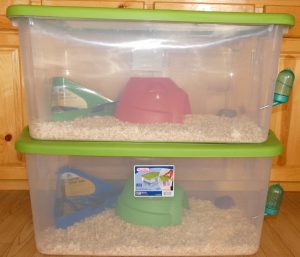 Large sterilite bins like the ones I use (18″x 30″ 120 quart clear) can make a good home for a hedgehog, as well as more complex, home-made enclosures. You should be sure that the walls are high enough that hedgie cannot climb out, and be sure the floors AND WALLS are made of a solid surface to avoid foot and leg injuries or hanging himself.
Large sterilite bins like the ones I use (18″x 30″ 120 quart clear) can make a good home for a hedgehog, as well as more complex, home-made enclosures. You should be sure that the walls are high enough that hedgie cannot climb out, and be sure the floors AND WALLS are made of a solid surface to avoid foot and leg injuries or hanging himself.
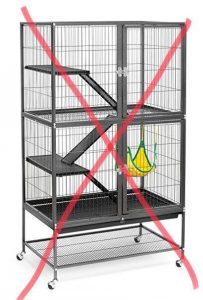
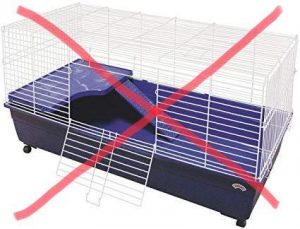 Avoid cages with ramps, multiple levels, and wire on the sides since a hedgehog will want to climb up like a ladder and can also get their head stuck and hang themselves with wire. Or even break a leg while climbing. For this reason, any cage with wire of ANY sort on the floor or the sides will VOID my health guarantee.
Avoid cages with ramps, multiple levels, and wire on the sides since a hedgehog will want to climb up like a ladder and can also get their head stuck and hang themselves with wire. Or even break a leg while climbing. For this reason, any cage with wire of ANY sort on the floor or the sides will VOID my health guarantee.
Accessorizing
Your hedgehog will need an exercise wheel to play on while you’re sleeping. Wire wheels are extremely dangerous and will VOID my health guarantee and contract. The best wheels for these creatures are at least 10” in diameter, and are made with a solid running surface. Wheels made from paint buckets (Bucket Wheels) are excellent and can be a fun do-it-yourself project. The important things are that your hedgehog’s feet and toenails should not get trapped in the wheel, as injury can result, and that the wheel clean up easily. Your hedgie also needs shallow bowls for food, and a water bottle.
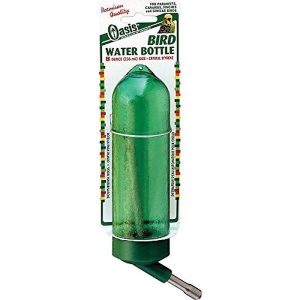 Here at Briar Patch we ONLY use Kordon Oasis Bird Bottles and HHOH drinker bottles. They are the only bottles I have found that allows enough water to flow out at one time to satisfy a thirsty hedgehog and avoid the common problems hedgehogs have with ordinary bottles.
Here at Briar Patch we ONLY use Kordon Oasis Bird Bottles and HHOH drinker bottles. They are the only bottles I have found that allows enough water to flow out at one time to satisfy a thirsty hedgehog and avoid the common problems hedgehogs have with ordinary bottles.
Since your hedgehog is a nocturnal, burrowing animal, s/he will need a private place to sleep during the day. Provide a place where your pet can feel secure, such as a hidey box, or little igloo as I use for my herd.
You’ll also need some sort of bedding for your pet’s home. Aspen or pine shavings are commonly used. NEVER USE CEDAR as the aromatic oils have been known to cause respiratory problems, lesions, and even death. If you choose to use Carefresh bedding or a similar product, please watch your hedgehog to be sure it is not eating the bedding.
Playtime and Socialization
Your hedgehog needs you! In order to develop a loving bond with your new friend, you need to handle him or her daily. Hedgehogs are naturally shy and cautious. Youngsters are even better at being super dramatic than older hedgies, but they can socialize well with patience and daily interaction. Snuggle time is a good way to win your hedgehog’s heart. While watching television or reading, you can hold your hedgie on your lap under a fleece blanket. This keeps your pet warm, and teaches him that you are a friend. Treats (like a meal worm, a wax worm, a bit of baked chicken, or a freeze-dried cricket) provided while your pet is on your lap will help build a positive bond. Talk to your hedgehog in quiet tones so that s/he becomes accustomed to your voice, and upon arriving home, offer your new hedgehog a worn t-shirt to sleep in. This will help your new pet associate your scent with security and comfort. Just make sure there are no loose strings on the shirt, as they can wrap around tiny legs. The key to winning your hedgehog’s trust is patience. Huffing, rolling into a ball and popping are his or her normal reactions to fear. Your hedgehog does not hate you if s/he does these things. It’s just that you’re a stranger—an unknown—and until you prove yourself otherwise, your pet might be frightened. Once you establish a relationship with your hedgehog, the bond is genuine on both sides.
Many hedgehogs love to explore, and once they are comfortable in their new homes they will enjoy free-ranging in a hedgie-proofed room while you supervise. If you do not feel confident letting your pet roam free, you should invest in some safe toys for out-of-cage play like a play pen with hidey houses, cat or ferret balls, or logs to burrow underneath.
Litter Training
Some hedgehogs can learn to use a litter box. Begin by choosing your hedgehog’s litter box, which can be any container that the hedgehog can easily climb into and that is large enough for him to turn around in, and which is resistant to moisture. Corner ferret litter boxes work very well. Add some sort of litter such as pine pellets, but remember to avoid cedar (see above) and clumping type cat litters as these may clump on or in the hedgehog’s genitals. Next, place a few stools in the box to help establish where they belong. Not all hedgehogs will learn to use a box, even though they are clean animals and usually like to keep their waste away from living areas. If your hedgehog does not take to the litter box, simply place litter under the base of his or her wheel and just clean the wheel daily. This is actually what I recommend doing. It gives more room in the cage without a litter pan.
You Are What You Eat
There is much debate as to what constitutes proper hedgehog nutrition. But there are certain things that most people agree on. First, unless there is a medical reason to feed something else, your hedgehog should eat a diet low in fat (around 15%), and moderately high in protein (at least 30%). And remember, while babies are growing fast and may need more calories, an adult hedgehog’s needs are different. I would not suggest feeding anything with corn, wheat, soy or meat/animal bi-products of any kinds. In fact the easy to find, low quality cat foods, hedgehog foods, and insectivore diets will VOID my health guarantee.
Kibble: Your breeder will give you a sample of the food your baby hedgehog is used to eating. If you chose to change this food, do it gradually, mixing a little more of the new food in every few days.
 For adult hedgehogs, I recommend pure Spike’s Delite Ultra. In general, look for a high-quality protein source listed as the first or second ingredient, and no corn, wheat, soy or meat bi-products as they are not good for hedgehogs. For most adult hedgehogs, 1-2 tablespoons of this staple mix should be fed daily.
For adult hedgehogs, I recommend pure Spike’s Delite Ultra. In general, look for a high-quality protein source listed as the first or second ingredient, and no corn, wheat, soy or meat bi-products as they are not good for hedgehogs. For most adult hedgehogs, 1-2 tablespoons of this staple mix should be fed daily.
Please don’t feed vegetables or fruit to your hedgehog. It is a common thought that we should offer them fresh produce as a treat every day, but this is unnecessary and could potentially do more harm than good. A hedgehog cannot properly digest plant matter. They are designed to eat insects and receive fiber from the exoskeleton of the bugs, called chitin.
Other foods: The staple food should be supplemented with other foods. Depending on your animal’s weight you can feed: 3 to 5 freeze-dried or live meal worms OR 2 crickets, OR a teaspoon of protein sources such as lean cooked chicken, slice of boiled egg, scrambled eggs, etc..
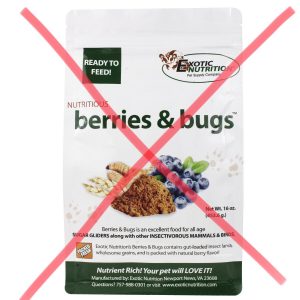
 Absolutely NEVER feed treats or staple foods containing nuts or dried fruits and veggies as they can cause dental problems or choking to death. These treats can kill your hedgehog! They will choke on the bits of dried fruit, vegetables, and grains.
Absolutely NEVER feed treats or staple foods containing nuts or dried fruits and veggies as they can cause dental problems or choking to death. These treats can kill your hedgehog! They will choke on the bits of dried fruit, vegetables, and grains.
Hedgehogs should never be fed grapes, onions, avocados, nuts, seeds, puffed grains, wild caught insects, fresh or dried fruits or veggies. Doing this will VOID your health guarantee.
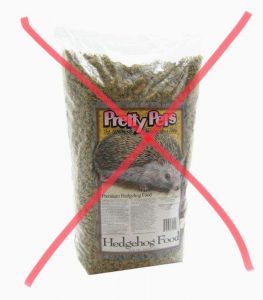

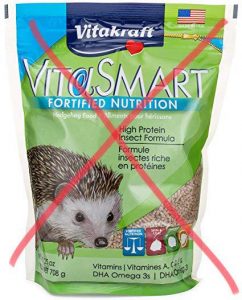
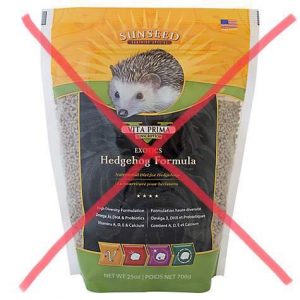
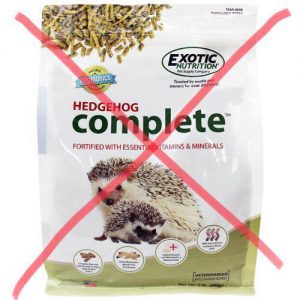 Never feed these foods to your hedgehog. They are not properly researched and some of these have bizarre ingredients.
Never feed these foods to your hedgehog. They are not properly researched and some of these have bizarre ingredients.
I suggest keeping away from corn and soy ingredients as a general rule of thumb.
Hedgehog Health Care
Keeping your hedgehog warm is very important. Since they come from a warm climate, your hedgehog cannot tolerate cooler temperatures. Keep your pet’s habitat away from drafts and around 75 – 80ºF but never above 82 degrees.
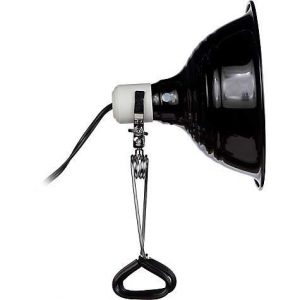
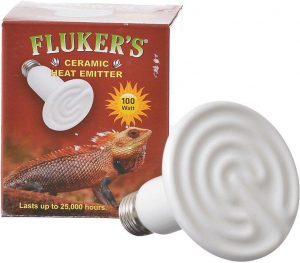 You should also have a supplemental heat source, like a Ceramic Heat Emitter (CHE) with clamp lamp, preferably plugged into a thermostat. A 150 watt infrared ceramic heat emitting bulb is best. African Pygmy Hedgehogs cannot actually hibernate, although they will go into a hypothermic state if they are too cool. This can be a life-threatening situation. In the summer, a hedgehog can also aestivate, or go into a lethargic state to conserve energy if temperatures are suddenly too high, and this should be avoided as well. If your hedgehog is too cool, they will seem uncoordinated and wobbly, have trouble walking, feel cool to the touch, and be somewhat less responsive than normal. Gradually warm your pet by keeping him/her tucked into your shirt, or by placing them in a fabric, carrying bag on top of a heating pad set to low. Do not leave your pet there for an extended time, and check on him/her often!
You should also have a supplemental heat source, like a Ceramic Heat Emitter (CHE) with clamp lamp, preferably plugged into a thermostat. A 150 watt infrared ceramic heat emitting bulb is best. African Pygmy Hedgehogs cannot actually hibernate, although they will go into a hypothermic state if they are too cool. This can be a life-threatening situation. In the summer, a hedgehog can also aestivate, or go into a lethargic state to conserve energy if temperatures are suddenly too high, and this should be avoided as well. If your hedgehog is too cool, they will seem uncoordinated and wobbly, have trouble walking, feel cool to the touch, and be somewhat less responsive than normal. Gradually warm your pet by keeping him/her tucked into your shirt, or by placing them in a fabric, carrying bag on top of a heating pad set to low. Do not leave your pet there for an extended time, and check on him/her often!
If your hedgehog gets too warm, they will “splat” out on their tummy, possibly in the open. S/he will be uninterested in food, and possibly unable to walk. Take the reverse approach by gradually cooling hedgie with a frozen soda bottle wrapped in a towel, or something similar. Aestivation is not as common as hypothermia, and most hedgehogs, if they are given a chance to adjust gradually to warm temperatures, do fine in the warmer months. Great variations in temperature are a problem—if your hedgie is used to having the air conditioning set at 72ºF all summer, and suddenly your power goes out, you will need to make sure s/he has a cool place as soon as possible.
Vet Visits
Your new hedgehog should see a vet for a healthy-hedgie check up within two weeks of arriving home. Some hedgehogs are more upset than others after changing homes, and you’ll need to look for loose or green, slimy stools which usually go away in a couple of days but could indicate a bacterial overgrowth in your pet’s intestines. Most hedgehog health care needs are surprisingly straightforward, if you are prepared. Common hedgehog ailments include obesity, quill loss(remember losing baby quills during their 6, 9 and 12 week quilling is normal!), tattered ears, and foot injuries can be prevented through proper diet, exercise, and routine care. Before the need arises, find a veterinarian in your area who has experience with hedgehogs. A yearly well-pet visit is recommended, as a good vet can catch many symptoms before they become emergencies. See your vet immediately if your hedgehog collapses, is limp, is having difficulty moving or breathing, is having seizures, shows discharge from eyes, nose(a wet nose is healthy, “discharge” would be like a dripping, snotty nose) or ears, has ingested a foreign substance, has blood in urine or feces, isn’t drinking water, or hasn’t eaten for more than two days.
